
Presentation Skills Unit Five Presentation Skills--Delivery Il.Presentation Delivery It's common in class to find: 台上:侃侃而谈,头头是道 台下:云遮雾绕,乱云飞渡 Different Feelings: The Speaker's Feeling:我说清楚了,对方听懂了 The Audience's Feeling:你说得不清楚,我也没听懂 What is important in the presentation delivery? 1.Voice a.Use your voice to show your enthusiasm about the presentation. b.Try to vary your voice in at least three ways: 1)Speaking volume a.Vary your speaking volume. (You can speak at normal volume.You can speak loudly and you can speak quietly.But you must speak loud enough so that everybody can hear you clearly throughout the presentation. b.Be ready to adjust (size of the room,number of people
1 Presentation Skills Unit Five Presentation Skills -- Delivery II. Presentation Delivery It’s common in class to find: 台上:侃侃而谈, 头头是道 台下:云遮雾绕,乱云飞渡 Different Feelings: The Speaker’s Feeling: 我说清楚了,对方听懂了 The Audience’s Feeling: 你说得不清楚,我也没听懂 What is important in the presentation delivery? 1. Voice a. Use your voice to show your enthusiasm about the presentation. b. Try to vary your voice in at least three ways: 1) Speaking volume a. Vary your speaking volume. (You can speak at normal volume. You can speak loudly and you can speak quietly. But you must speak loud enough so that everybody can hear you clearly throughout the presentation. ) b. Be ready to adjust (size of the room, number of people

availability of a microphone,background noise) Common Problems in speaking volume: -Too low -Insensitive to signals from the audience indicating problems in volume. 2)Speaking rate a.Vary your speaking rate. --you can speak at normal speed --you can speak faster --you can speak more slowly --you can stop completely!You can pause to draw attention to key thoughts. b.Fluency is important,but don't speak too fast. Common Problems in speaking rate: --The same rate,pure reading --No adjustment for comprehension and expressiveness. 3)Intonation Vary the pitch of your voice. 2
2 availability of a microphone, background noise) Common Problems in speaking volume: -- Too low -- Insensitive to signals from the audience indicating problems in volume. 2) Speaking rate a. Vary your speaking rate. -- you can speak at normal speed -- you can speak faster -- you can speak more slowly -- you can stop completely! You can pause to draw attention to key thoughts. b. Fluency is important, but don’t speak too fast. Common Problems in speaking rate: -- The same rate, pure reading -- No adjustment for comprehension and expressiveness. 3) Intonation Vary the pitch of your voice
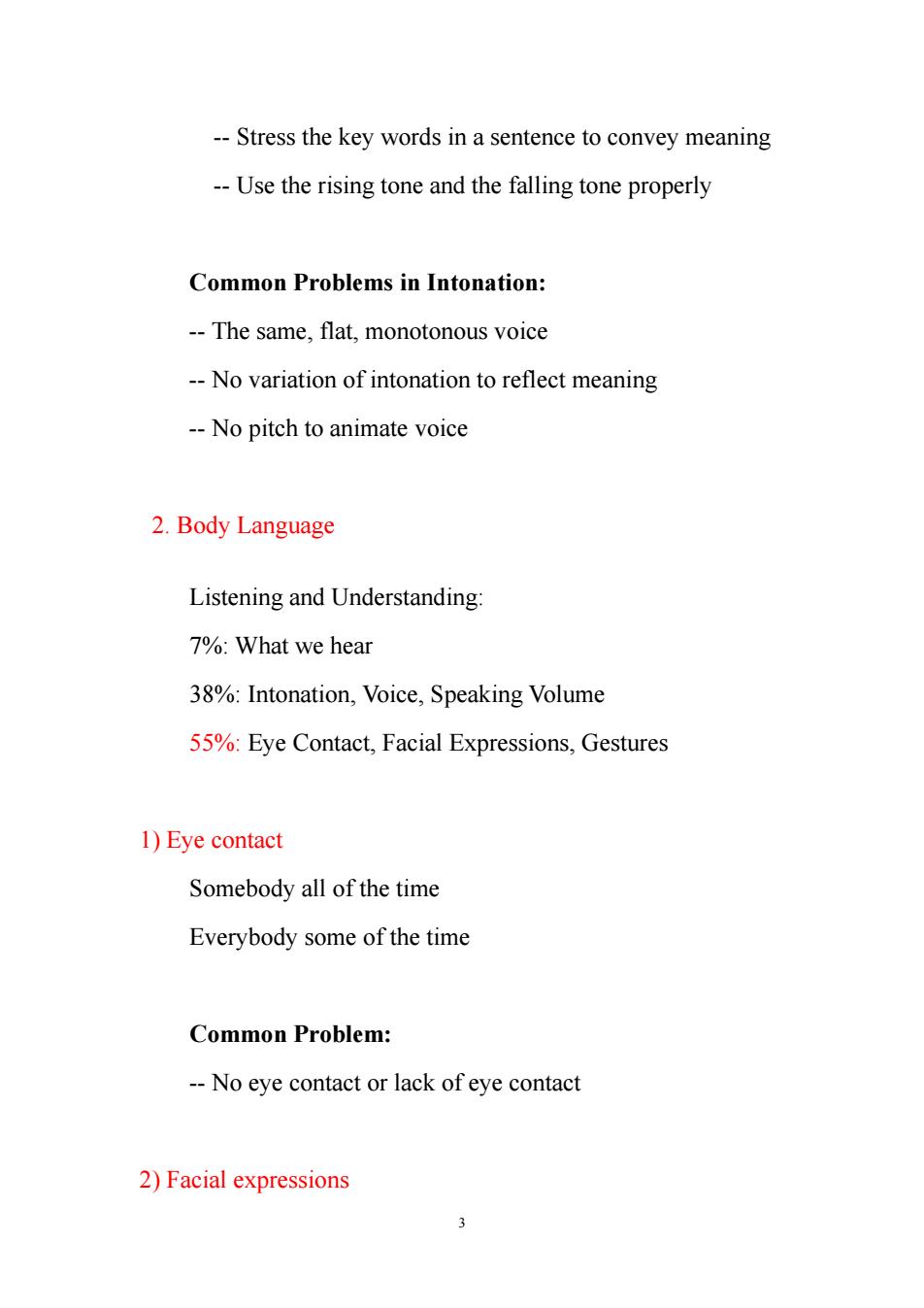
--Stress the key words in a sentence to convey meaning --Use the rising tone and the falling tone properly Common Problems in Intonation: --The same,flat,monotonous voice --No variation of intonation to reflect meaning --No pitch to animate voice 2.Body Language Listening and Understanding: 7%:What we hear 38%:Intonation,Voice,Speaking Volume 55%:Eye Contact,Facial Expressions,Gestures 1)Eye contact Somebody all of the time Everybody some of the time Common Problem: --No eye contact or lack of eye contact 2)Facial expressions
3 -- Stress the key words in a sentence to convey meaning -- Use the rising tone and the falling tone properly Common Problems in Intonation: -- The same, flat, monotonous voice -- No variation of intonation to reflect meaning -- No pitch to animate voice 2. Body Language Listening and Understanding: 7%: What we hear 38%: Intonation, Voice, Speaking Volume 55%: Eye Contact, Facial Expressions, Gestures 1) Eye contact Somebody all of the time Everybody some of the time Common Problem: -- No eye contact or lack of eye contact 2) Facial expressions
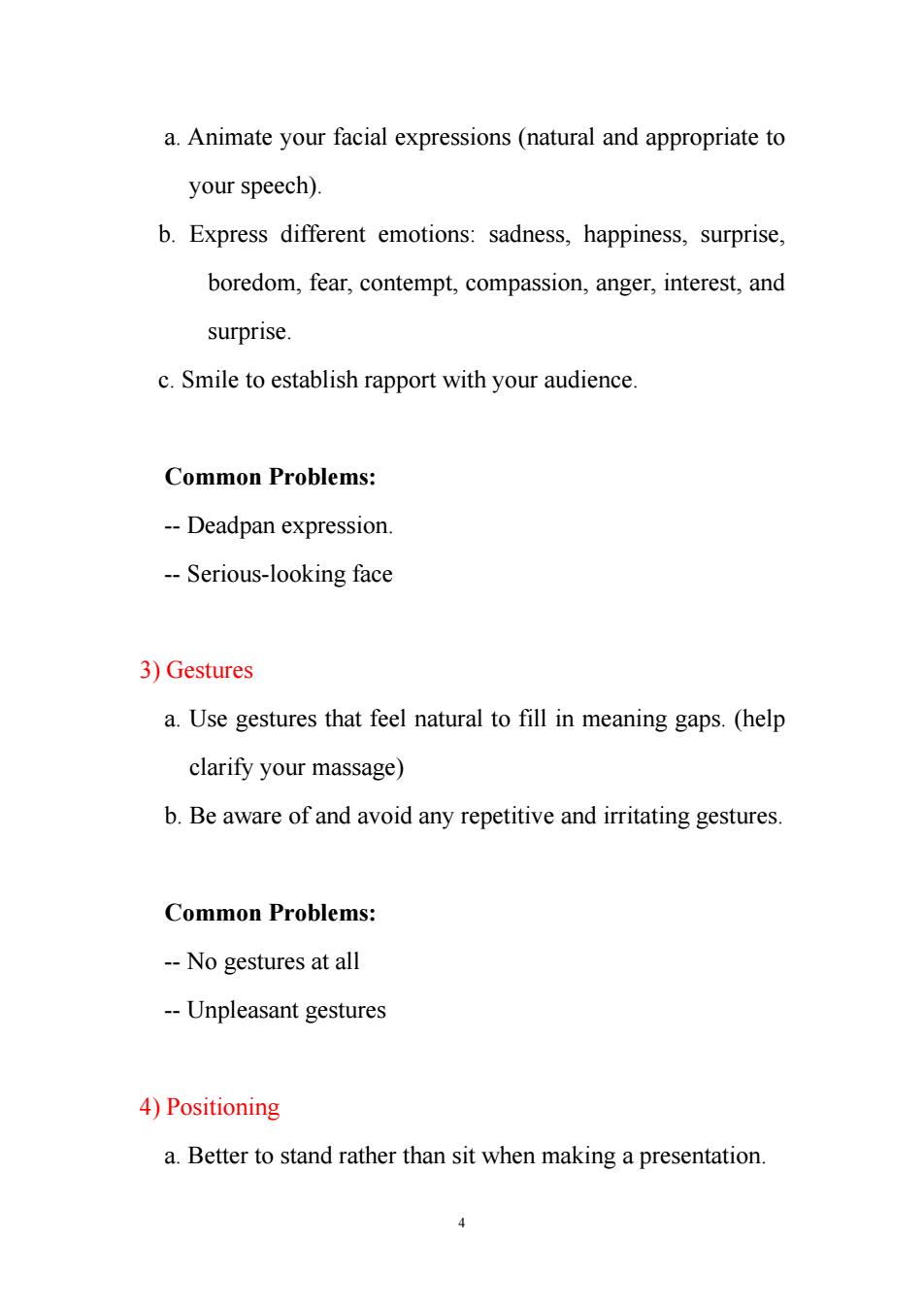
a.Animate your facial expressions(natural and appropriate to your speech). b.Express different emotions:sadness,happiness,surprise, boredom,fear,contempt,compassion,anger,interest,and surprise. c.Smile to establish rapport with your audience. Common Problems: --Deadpan expression. -Serious-looking face 3)Gestures a.Use gestures that feel natural to fill in meaning gaps.(help clarify your massage) b.Be aware of and avoid any repetitive and irritating gestures. Common Problems: --No gestures at all --Unpleasant gestures 4)Positioning a.Better to stand rather than sit when making a presentation
4 a. Animate your facial expressions (natural and appropriate to your speech). b. Express different emotions: sadness, happiness, surprise, boredom, fear, contempt, compassion, anger, interest, and surprise. c. Smile to establish rapport with your audience. Common Problems: -- Deadpan expression. -- Serious-looking face 3) Gestures a. Use gestures that feel natural to fill in meaning gaps. (help clarify your massage) b. Be aware of and avoid any repetitive and irritating gestures. Common Problems: -- No gestures at all -- Unpleasant gestures 4) Positioning a. Better to stand rather than sit when making a presentation

b.Position yourself so that you are physically close to the audience c.Move around at a comfortable,natural pace. d.Being natural,relaxed and comfortable. Common Problem: --Standing stiffly 3.Language 1)Language difficulty -“Kiss”Principle-Keep It Short and Simple. --Make the language style spoken,rather than written. a.Use short words and short sentences. b.Do not use jargon,unless you are certain that your audience understands it. c.Avoid using slang in presentations d.Talk about concrete facts rather than abstract ideas. e.Use active verbs instead of passive verbs. e.g.Toyota sold two million cars last year.(Easier and more direct.) Two million cars were sold by Toyota last year. 2)Signaling(Signposting,or Transitional words) 5
5 b. Position yourself so that you are physically close to the audience c. Move around at a comfortable, natural pace. d. Being natural, relaxed and comfortable. Common Problem: -- Standing stiffly 3. Language 1) Language difficulty -- “Kiss” Principle – Keep It Short and Simple. -- Make the language style spoken, rather than written. a. Use short words and short sentences. b. Do not use jargon, unless you are certain that your audience understands it. c. Avoid using slang in presentations d. Talk about concrete facts rather than abstract ideas. e. Use active verbs instead of passive verbs. e.g. Toyota sold two million cars last year. (Easier and more direct.) Two million cars were sold by Toyota last year. 2) Signaling (Signposting, or Transitional words)

a.For clear organization. b.To let the audience know where they are. So,signpost for the audience,at the beginning and all along the route. e.g.During your introduction,you should tell your audience what the structure of your presentation will be.You might say something like this: "I'll start by describing the current position in Europe.Then I'll move on to some of the achievements we've made in Asia. After that I'll consider the opportunities we see for further expansion in Africa. The audience can now visualize your presentation. The table below lists useful expressions that you can use to signpost the various parts of your presentation: Function Language Introducing the subject 。I'd like to start by.. ·Let's begin by.. First of all,I'll... Starting with... I'll begin by... Finishing one subject... Well,I've told you about... That's all I have to say about... 。We've looked at. So much for... ...and starting another Now we'll move on to
6 a. For clear organization. b. To let the audience know where they are. So, signpost for the audience, at the beginning and all along the route. e.g. During your introduction, you should tell your audience what the structure of your presentation will be. You might say something like this: "I'll start by describing the current position in Europe. Then I'll move on to some of the achievements we've made in Asia. After that I'll consider the opportunities we see for further expansion in Africa. The audience can now visualize your presentation. The table below lists useful expressions that you can use to signpost the various parts of your presentation: Function Language Introducing the subject I'd like to start by... Let's begin by... First of all, I'll... Starting with... I'll begin by... Finishing one subject... Well, I've told you about... That's all I have to say about... We've looked at... So much for... ...and starting another Now we'll move on to
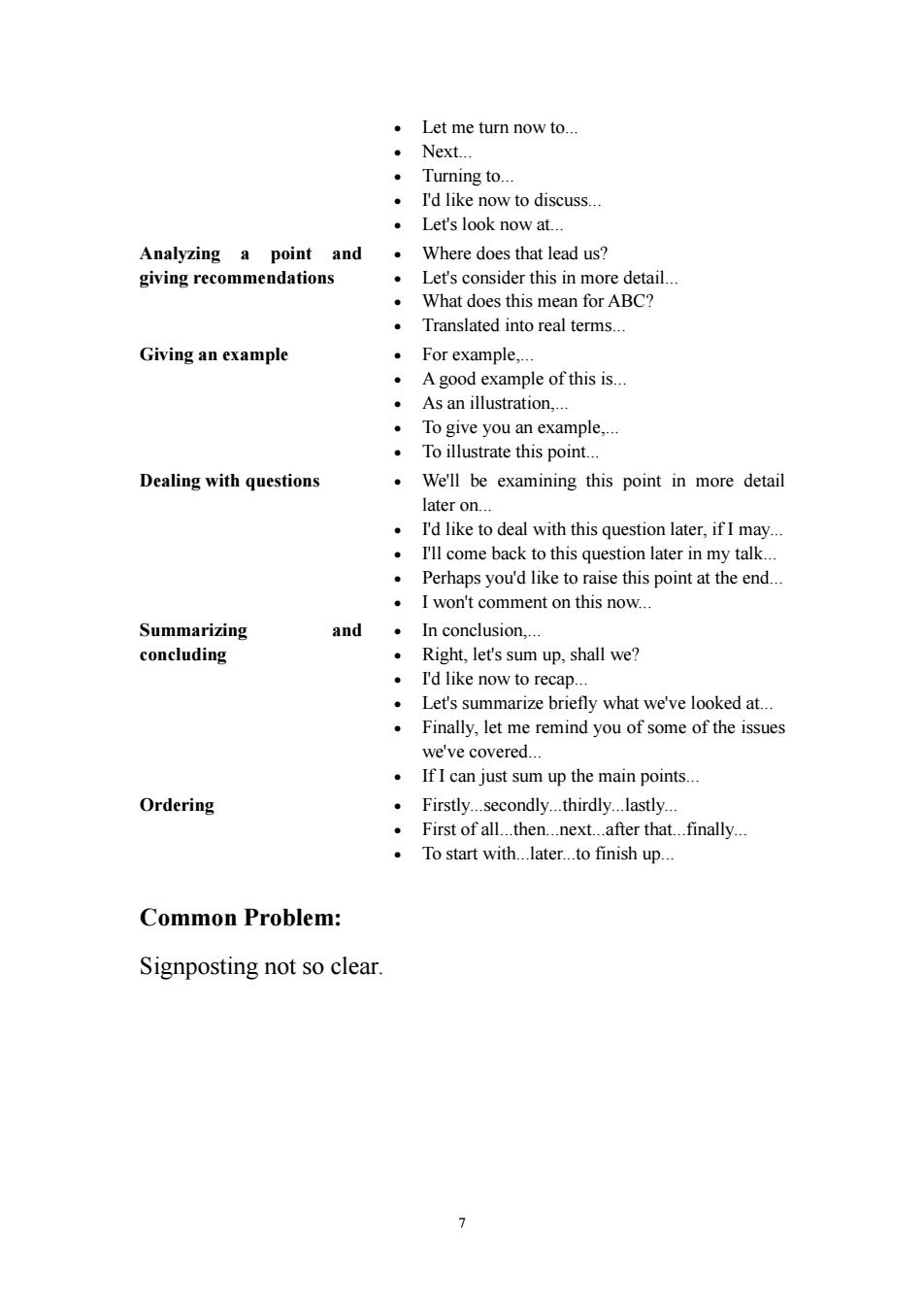
·Let me turn now to.. 。 Next... Turning to.. 。 I'd like now to discuss... 。Let's look now at... Analyzing a point and Where does that lead us? giving recommendations Let's consider this in more detail... What does this mean for ABC? Translated into real terms... Giving an example For example,.… A good example of this is... 。As an illustration,..… To give you an example,... To illustrate this point... Dealing with questions We'll be examining this point in more detail later on.… I'd like to deal with this question later,if I may... I'll come back to this question later in my talk... Perhaps you'd like to raise this point at the end... I won't comment on this now... Summarizing and ·In conclusion... concluding Right,let's sum up,shall we? 。I'd like now to recap. Let's summarize briefly what we've looked at... Finally,let me remind you of some of the issues we've covered... If I can just sum up the main points... Ordering Firstly...secondly...thirdly...lastly... First of all...then.next...after that...finally... To start with...later...to finish up... Common Problem: Signposting not so clear. >
7 Let me turn now to... Next... Turning to... I'd like now to discuss... Let's look now at... Analyzing a point and giving recommendations Where does that lead us? Let's consider this in more detail... What does this mean for ABC? Translated into real terms... Giving an example For example,... A good example of this is... As an illustration,... To give you an example,... To illustrate this point... Dealing with questions We'll be examining this point in more detail later on... I'd like to deal with this question later, if I may... I'll come back to this question later in my talk... Perhaps you'd like to raise this point at the end... I won't comment on this now... Summarizing and concluding In conclusion,... Right, let's sum up, shall we? I'd like now to recap... Let's summarize briefly what we've looked at... Finally, let me remind you of some of the issues we've covered... If I can just sum up the main points... Ordering Firstly...secondly...thirdly...lastly... First of all...then...next...after that...finally... To start with...later...to finish up... Common Problem: Signposting not so clear
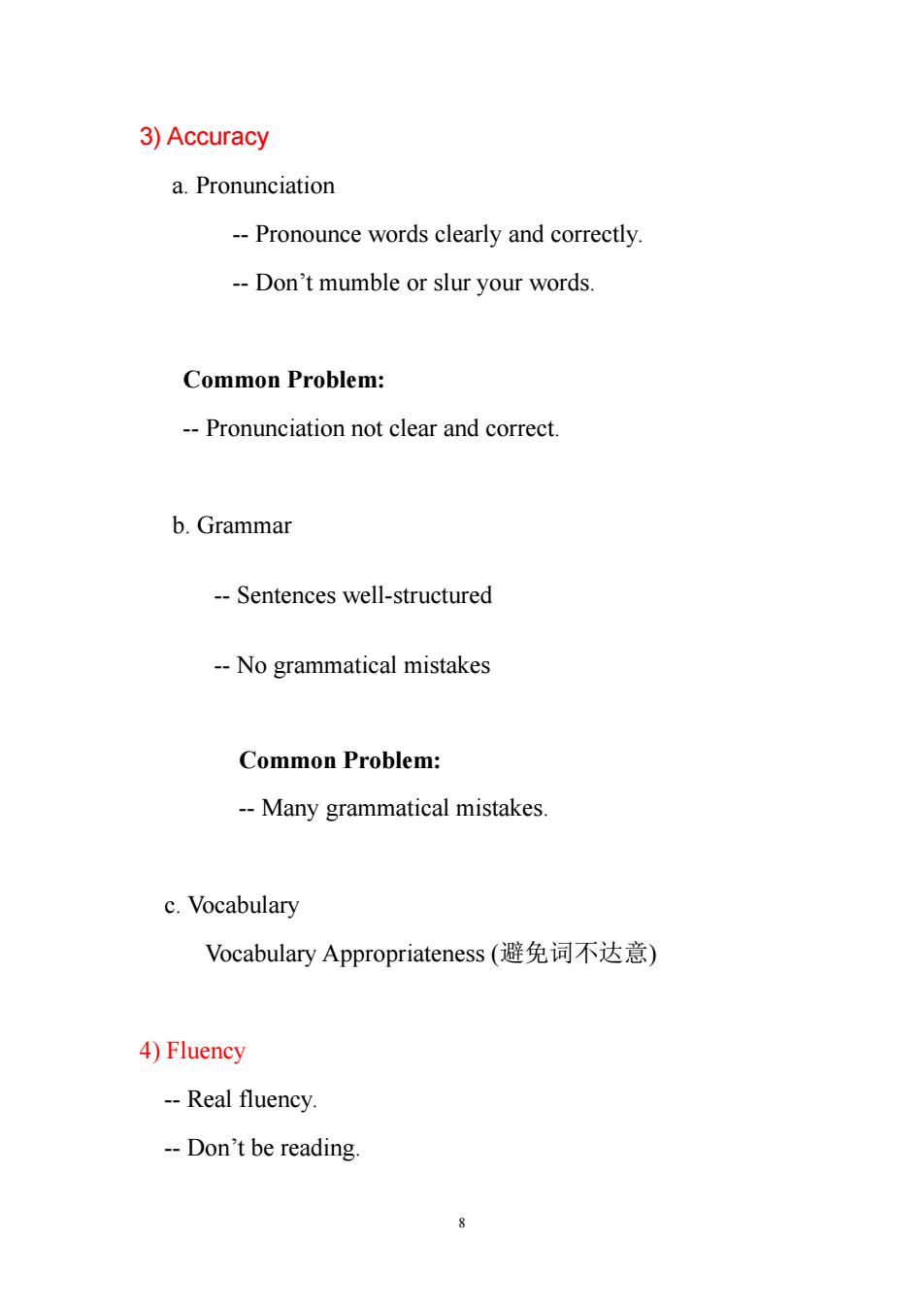
3)Accuracy a.Pronunciation --Pronounce words clearly and correctly. --Don't mumble or slur your words. Common Problem: --Pronunciation not clear and correct. b.Grammar --Sentences well-structured --No grammatical mistakes Common Problem: --Many grammatical mistakes. c.Vocabulary Vocabulary Appropriateness(避免词不达意) 4)Fluency --Real fluency. --Don't be reading
8 3) Accuracy a. Pronunciation -- Pronounce words clearly and correctly. -- Don’t mumble or slur your words. Common Problem: -- Pronunciation not clear and correct. b. Grammar -- Sentences well-structured -- No grammatical mistakes Common Problem: -- Many grammatical mistakes. c. Vocabulary Vocabulary Appropriateness (避免词不达意) 4) Fluency -- Real fluency. -- Don’t be reading

a.Be as spontaneous as possible. b.Be familiar with your subject and with the information that you want to deliver. c.Reading is boring!Reading will make your audience go to sleep! Common Problem: --Too much reading IV.Recovery Tactics: Problem Situation Recovery Tactic Recovery Phrase 1.You can't think of the Find another word. What's the word word in English Paraphrase. expression? Let me say it another way. 2.Can't pronounce a Find another word. What's the word/ word correctly. Repeat the word. expression? Write the word. Let me say it another way. 3.You don't have Refer them to the So,just let me give you enough time to finish handout for more the main points.You can detailed information. read the handout for more detail. Skip a less important I am going to skip this detail. part and go on to the next part. 4.Your explanation is Say in simple words. So,basically,what I'm too complex. Give a very simple saying is this. example. Just a simple example... 5.You forgot to say Say it as soon as you Sorry,I forgot to mention something important. realize you have one important point. 9
9 a. Be as spontaneous as possible. b. Be familiar with your subject and with the information that you want to deliver. c. Reading is boring! Reading will make your audience go to sleep! Common Problem: -- Too much reading IV. Recovery Tactics: Problem Situation Recovery Tactic Recovery Phrase 1. You can’t think of the word in English Find another word. Paraphrase. What’s the word / expression? Let me say it another way. 2. Can’t pronounce a word correctly. Find another word. Repeat the word. Write the word. What’s the word/ expression? Let me say it another way. 3. You don’t have enough time to finish Refer them to the handout for more detailed information. Skip a less important detail. So, just let me give you the main points. You can read the handout for more detail. I am going to skip this part and go on to the next part. 4. Your explanation is too complex. Say in simple words. Give a very simple example. So, basically, what I’m saying is this. Just a simple example… 5. You forgot to say something important. Say it as soon as you realize you have Sorry, I forgot to mention one important point
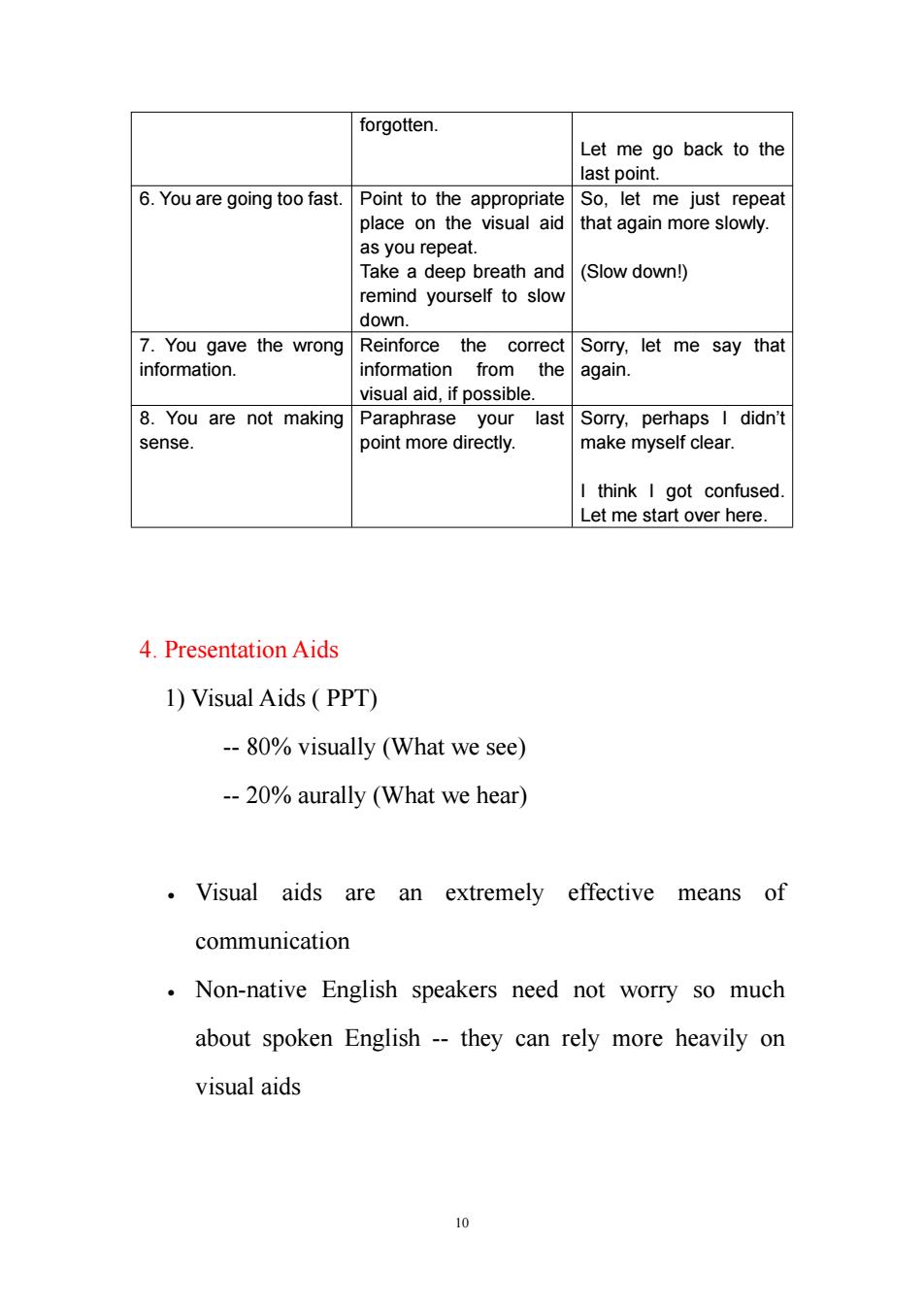
forgotten. Let me go back to the last point. 6.You are going too fast. Point to the appropriate So,let me just repeat place on the visual aid that again more slowly. as you repeat. Take a deep breath and (Slow down!) remind yourself to slow down. 7.You gave the wrong Reinforce the correct Sorry,let me say that information. information from the again. visual aid,if possible. 8.You are not making Paraphrase your last Sorry,perhaps I didn't sense. point more directly. make myself clear. I think I got confused Let me start over here. 4.Presentation Aids 1)Visual Aids PPT) --80%visually (What we see) --20%aurally (What we hear) Visual aids are an extremely effective means of communication Non-native English speakers need not worry so much about spoken English -they can rely more heavily on visual aids o
10 forgotten. Let me go back to the last point. 6. You are going too fast. Point to the appropriate place on the visual aid as you repeat. Take a deep breath and remind yourself to slow down. So, let me just repeat that again more slowly. (Slow down!) 7. You gave the wrong information. Reinforce the correct information from the visual aid, if possible. Sorry, let me say that again. 8. You are not making sense. Paraphrase your last point more directly. Sorry, perhaps I didn’t make myself clear. I think I got confused. Let me start over here. 4. Presentation Aids 1) Visual Aids ( PPT) -- 80% visually (What we see) -- 20% aurally (What we hear) Visual aids are an extremely effective means of communication Non-native English speakers need not worry so much about spoken English -- they can rely more heavily on visual aids